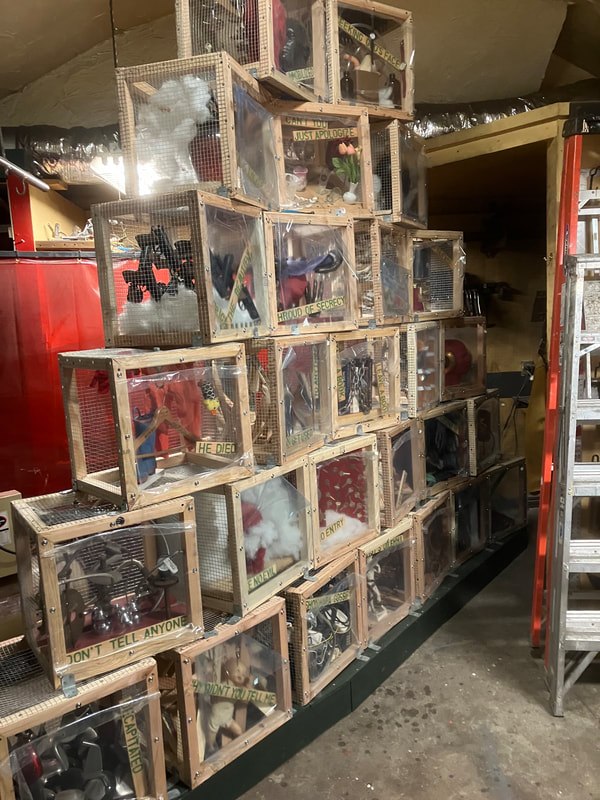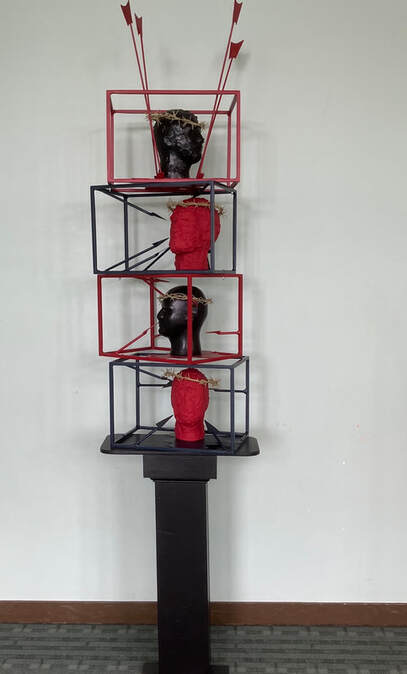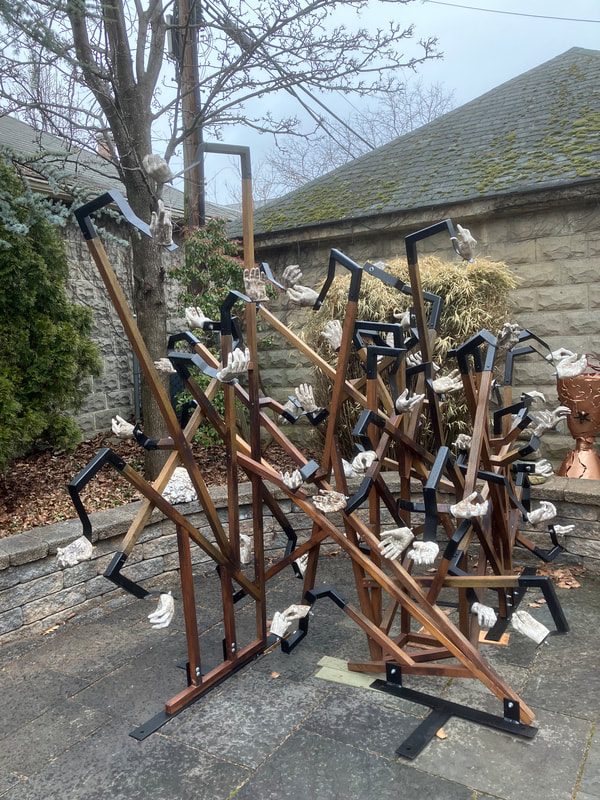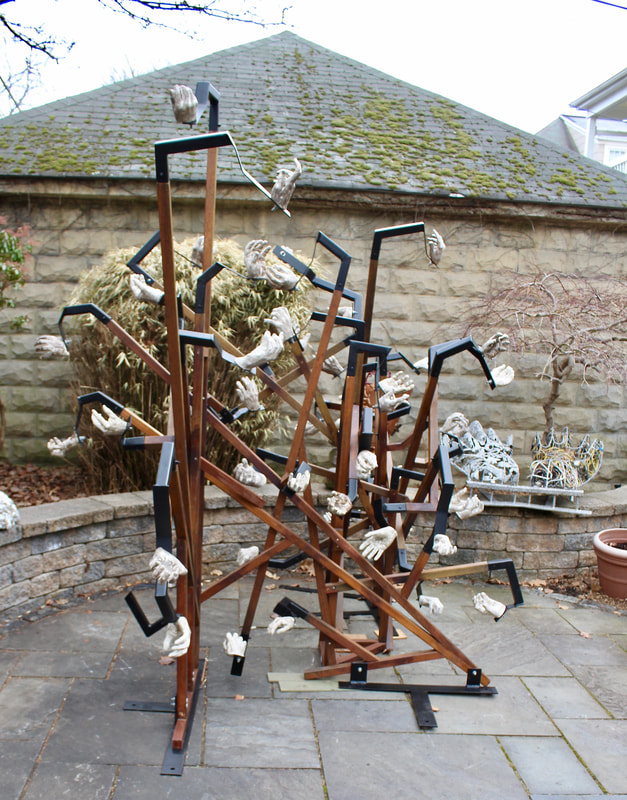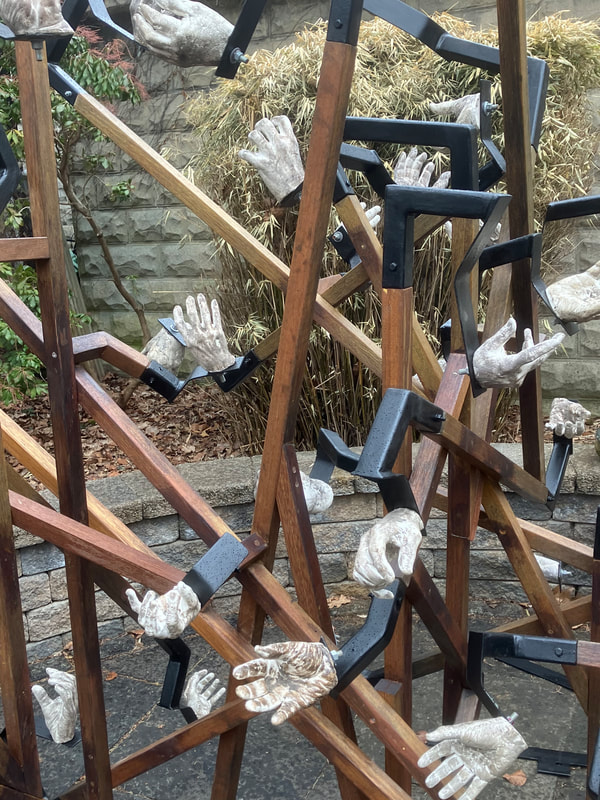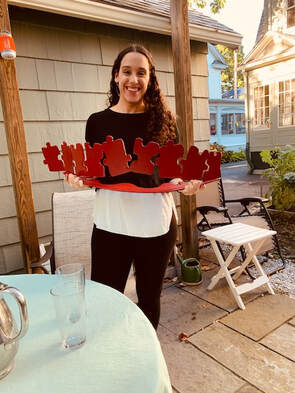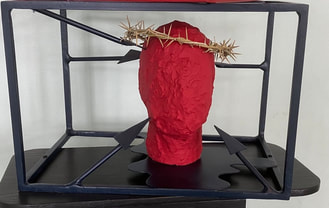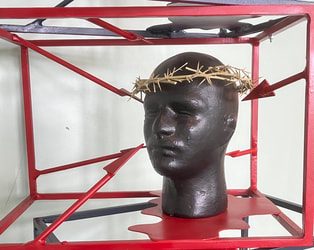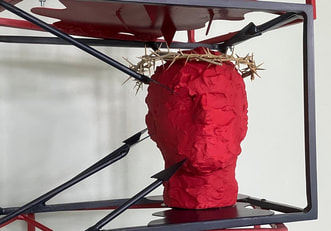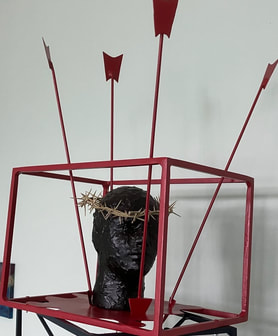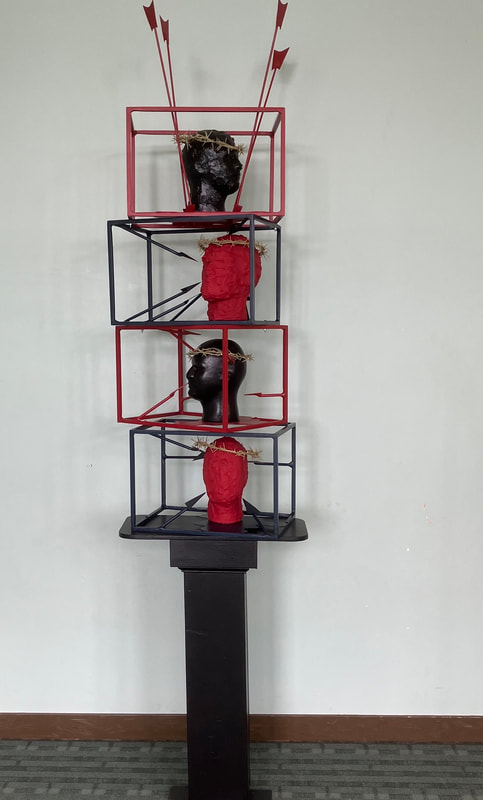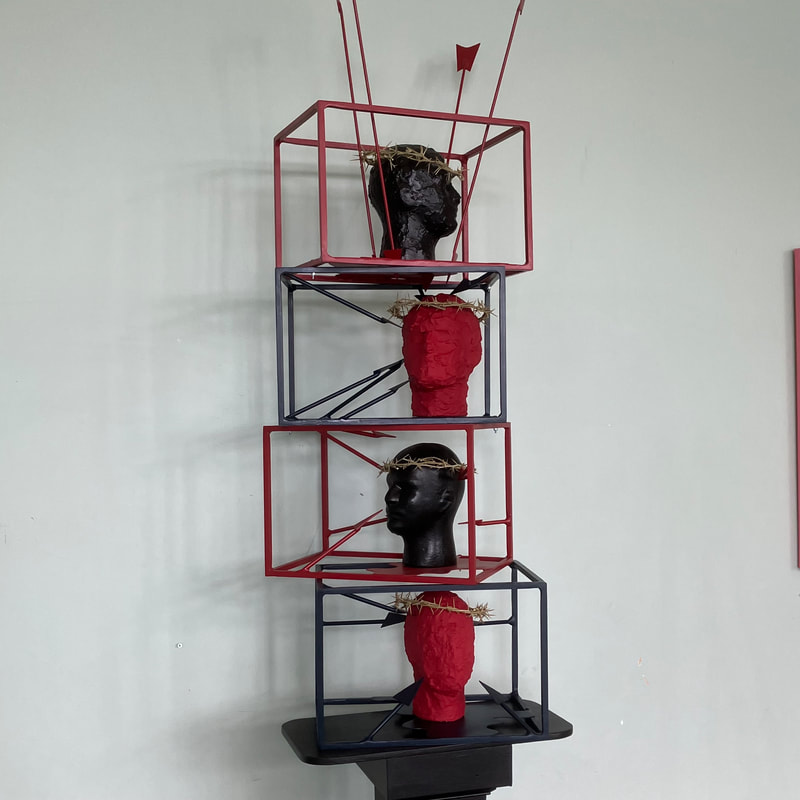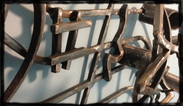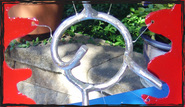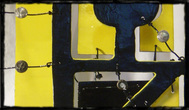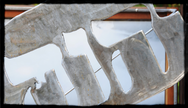studio without walls 2024 (SWW) sculpture show
celebrates 25 years
allen's new sculpture, 28 secrets, will be part of this show
(see below)
28 Secrets (2024)
MATERIALS: Wood, wire mesh, acrylic plastic, assorted household objects
DIMENSIONS: Sculpture (28 cubes) 11’ L x 26” W x 12’ H (cube is 18” x 18” x 16”)
Memory and secrets are intertwined and inseparable, each the mirror image of the other. Memories stitch together how we construct the outside world that others see, and secrets shape the inner life we conceal from others. When we bury some memories, they become our secrets. Artists depend so much on mining their memories and secrets, because they are a rich and indispensable reservoir for artmaking. The question is how much to reveal.
28 Secrets explores the secrets that animate our lives-deeply personal secrets, family secrets, societal secrets. Even God holds secrets that remain inaccessible to us. Our secrets imprison us, forcing us to navigate life with caution and trepidation so as not to expose confidences and sordid tales that might bring shame and derision on us or our family. Our communities and society-at-large hold secrets too-preserving untruths and myths about who we are and how we’ve treated others; collective secrets that sustain destructive, dehumanizing beliefs and customs. For each of us, the challenge remains finding ways to bring some release from our secrets. As you consider 28 Secrets, what secrets impact and affect your life and what might need to happen to release you from their stranglehold?
The design and display of these cubes have been influenced by Joseph Cornell’s Assemblages. I’m also honoring the 25th anniversary of SWW by including in this sculpture remnants of other sculptures I’ve displayed in SWW shows between 2019-2023. Artmaking is the cultivation of vulnerability and I’ve been able to do that through this wonderful outdoor art exhibition. (See below for a complete description of each cube.)
Description of Each Cube
R1 C1 DECAPITATED (golf club heads) hiding our secrets can feel like we’re missing a part of ourselves
R1 C2 WHY DIDN’T YOU TELL ME (wood slats & doll) what happens when some hidden secret is revealed to you?
R1 C3 LASHON HARA-GOSSIP (cables) the destructive consequence of spreading lies and untruths through gossip (2021 SWW Show)
R1 C4 ARTIST’S DILEMMA (ropes & Michelangelo) we explore our secrets for artistic inspiration and yet, how much can we disclose/expose?
R1 C5 BROKEN VESSEL (pottery shards) can we find ways to repair/restore what’s become broken?
R1 C6 WHAT ARE YOU HIDING (spikes & violin) the beauty we’ve created in our lives is often sabotaged by the secrets we hold
R1 C7 LOST LEGACY (flowers & jewelry) finding out that family memories have been buried as myths, lies and secrets
R2 C8 DON’T TELL ANYONE (plumbing fixtures) must we honor the obligation to remain silent?
R2 C9 SEE NO EVIL (pillow stuffing with head) how we have survived with the secrets we live with
R2 C10 NO ENTRY (keys and locks) guarding our secrets, so nobody ever knows (2021 SWW Show)
R2 C11 TRAPPED (rat traps & doll) feeling imprisoned and incapacitated by our secrets (2023 SWW Show)
R2 C12 LOSING IT… (gloves) suffering loss and death from those closest to us (2019 SWW Show)
R2 C13 NOW I UNDERSTAND (electrical fixtures) an awakening to the consequences of our secrets
R3 C14 HE DIED (hangers & clothes) my father’s death left me empty and abandoned and seeking the truth
R3 C15 I CAN GET USED TO ANYTHING (mirror glass) family estrangement based on lies and misunderstandings (2023 SWW Show)
R3 C16 TAKE A BOOK, LEAVE A BOOK (books and locks) can we find the truths in books that might open us to a new understanding of ourselves?
R3 C17 MY FAMILY TREE (silverware & pill bottles) family violence is the most virulent hidden epidemic of society
R3 C18 HEAR NO EVIL (pillow stuffing and head) how we have survived with the secrets we live with
R4 C19 AMERICA THE BEAUTIFUL (hanging guns) Americans live with a deep, dark secret that we are a compassionate, merciful country
R4 C20 SHROUD OF SECRECY (plastic hands and cloth) keep everything hidden no matter what
R4 C21 GARDEN OF A 1000 DEATHS (hands and flowers) remembering the victims of genocide, all but forgotten (2022 SWW Show)
R4 C22 25 CENTS PLEASE (gum machine with guns) Americans live with a deep, dark secret that we are a compassionate, merciful country
R5 C23 BLOOD IS THICKER… (glass decanter & blood) we’ve conjured sanitized myths about our allegedly ‘healthy’ family
R5 C24 JUST APOLOGIZE (table with objects) the risks and failures (and perhaps rewards?) of conversation (2023 SWW Show)
R5 C25 SPEAK NO EVIL (pillow stuffing and head) how we have survived with the secrets we live with.
R6 C26 IMMOBILIZED (two heads with saw blade) discovering truths about our lives may leave us incapable of action, even paralyzed
R6 C27 SEEKING GOD’S FACE (brown bottles and plastic tubes) God hides secrets too. God might offer us a way to escape ours
R7 C28 CROWN OF THORNS (head, arrows, and crown) our excruciating secrets make us suffer and suffer more
MATERIALS: Wood, wire mesh, acrylic plastic, assorted household objects
DIMENSIONS: Sculpture (28 cubes) 11’ L x 26” W x 12’ H (cube is 18” x 18” x 16”)
Memory and secrets are intertwined and inseparable, each the mirror image of the other. Memories stitch together how we construct the outside world that others see, and secrets shape the inner life we conceal from others. When we bury some memories, they become our secrets. Artists depend so much on mining their memories and secrets, because they are a rich and indispensable reservoir for artmaking. The question is how much to reveal.
28 Secrets explores the secrets that animate our lives-deeply personal secrets, family secrets, societal secrets. Even God holds secrets that remain inaccessible to us. Our secrets imprison us, forcing us to navigate life with caution and trepidation so as not to expose confidences and sordid tales that might bring shame and derision on us or our family. Our communities and society-at-large hold secrets too-preserving untruths and myths about who we are and how we’ve treated others; collective secrets that sustain destructive, dehumanizing beliefs and customs. For each of us, the challenge remains finding ways to bring some release from our secrets. As you consider 28 Secrets, what secrets impact and affect your life and what might need to happen to release you from their stranglehold?
The design and display of these cubes have been influenced by Joseph Cornell’s Assemblages. I’m also honoring the 25th anniversary of SWW by including in this sculpture remnants of other sculptures I’ve displayed in SWW shows between 2019-2023. Artmaking is the cultivation of vulnerability and I’ve been able to do that through this wonderful outdoor art exhibition. (See below for a complete description of each cube.)
Description of Each Cube
R1 C1 DECAPITATED (golf club heads) hiding our secrets can feel like we’re missing a part of ourselves
R1 C2 WHY DIDN’T YOU TELL ME (wood slats & doll) what happens when some hidden secret is revealed to you?
R1 C3 LASHON HARA-GOSSIP (cables) the destructive consequence of spreading lies and untruths through gossip (2021 SWW Show)
R1 C4 ARTIST’S DILEMMA (ropes & Michelangelo) we explore our secrets for artistic inspiration and yet, how much can we disclose/expose?
R1 C5 BROKEN VESSEL (pottery shards) can we find ways to repair/restore what’s become broken?
R1 C6 WHAT ARE YOU HIDING (spikes & violin) the beauty we’ve created in our lives is often sabotaged by the secrets we hold
R1 C7 LOST LEGACY (flowers & jewelry) finding out that family memories have been buried as myths, lies and secrets
R2 C8 DON’T TELL ANYONE (plumbing fixtures) must we honor the obligation to remain silent?
R2 C9 SEE NO EVIL (pillow stuffing with head) how we have survived with the secrets we live with
R2 C10 NO ENTRY (keys and locks) guarding our secrets, so nobody ever knows (2021 SWW Show)
R2 C11 TRAPPED (rat traps & doll) feeling imprisoned and incapacitated by our secrets (2023 SWW Show)
R2 C12 LOSING IT… (gloves) suffering loss and death from those closest to us (2019 SWW Show)
R2 C13 NOW I UNDERSTAND (electrical fixtures) an awakening to the consequences of our secrets
R3 C14 HE DIED (hangers & clothes) my father’s death left me empty and abandoned and seeking the truth
R3 C15 I CAN GET USED TO ANYTHING (mirror glass) family estrangement based on lies and misunderstandings (2023 SWW Show)
R3 C16 TAKE A BOOK, LEAVE A BOOK (books and locks) can we find the truths in books that might open us to a new understanding of ourselves?
R3 C17 MY FAMILY TREE (silverware & pill bottles) family violence is the most virulent hidden epidemic of society
R3 C18 HEAR NO EVIL (pillow stuffing and head) how we have survived with the secrets we live with
R4 C19 AMERICA THE BEAUTIFUL (hanging guns) Americans live with a deep, dark secret that we are a compassionate, merciful country
R4 C20 SHROUD OF SECRECY (plastic hands and cloth) keep everything hidden no matter what
R4 C21 GARDEN OF A 1000 DEATHS (hands and flowers) remembering the victims of genocide, all but forgotten (2022 SWW Show)
R4 C22 25 CENTS PLEASE (gum machine with guns) Americans live with a deep, dark secret that we are a compassionate, merciful country
R5 C23 BLOOD IS THICKER… (glass decanter & blood) we’ve conjured sanitized myths about our allegedly ‘healthy’ family
R5 C24 JUST APOLOGIZE (table with objects) the risks and failures (and perhaps rewards?) of conversation (2023 SWW Show)
R5 C25 SPEAK NO EVIL (pillow stuffing and head) how we have survived with the secrets we live with.
R6 C26 IMMOBILIZED (two heads with saw blade) discovering truths about our lives may leave us incapable of action, even paralyzed
R6 C27 SEEKING GOD’S FACE (brown bottles and plastic tubes) God hides secrets too. God might offer us a way to escape ours
R7 C28 CROWN OF THORNS (head, arrows, and crown) our excruciating secrets make us suffer and suffer more
Reflections on my ten years as a sculptor
I’ve been a practicing sculptor now for ten years. It feels like an appropriate time to consider how my decision to leave a social work career and pursue an artist’s life has changed the way I spend my time, what I think about, how my significant relationships have evolved and what I’ve discovered about the artist’s life.
It’s certainly true that I wanted to make sculpture for decades, but there were too many life commitments that made that impossible-a family to raise, work, extended family responsibilities and no real confidence about how to be an artist. Sure, I visited museums, read about the lives of artists, and dabbled in something resembling artmaking, but when I was finally given ‘permission’ by a social work supervisor who suggested I consider becoming a sculptor, I had no idea where this decision would take me or how I would get there. Like so many adventures and risks I’ve taken in my life, I knew that I would find a way to make it happen (with the support of family and friends).
Making art is not fun and there is no place I’d rather be than in my studio. I walk in and feel that time and space has been suspended. My affect changes and my focus intensifies. Working with steel is dirty and my hands inevitably pick up steel splinters (even though I wear gloves.) Making art is a singular activity, so I spend many hours alone with my thoughts as I grind away to fabricate and shape. While much of my previous work life was spent in groups- collaborating, compromising, organizing, strategizing-making art is solitary. By necessity, I’ve become more self-absorbed and self-centered, and it’s affected some of my relationships. I consider the singular focus on art making as one of the ‘tools of the trade,’ the price I’ve had to pay for making this change.
A famous Jewish thinker, Rashi, wrote the following: skill is what a person learns from others; ability is the result of one’s own insight and experience; knowledge is divine inspiration. I can think of no better description of the artist’s world-learning from mentors and peers; honing skills and my artistic sensibilities, both technical and emotional; and then unlocking those magical moments of creating that come from nowhere/somewhere. For me, these ‘knowledge’ moments seem to come just before I wake up, when I work through a technical issue or envision a way to express an idea in sculptural form.
During my early years as a sculptor, I made sculpture fast and furious. Then I slowed down and started to make larger and more complex work. I’ve been honored to be in sculpture shows and thank all the curators who found my work compelling enough to show. Now, at age 74, I've decided that making and moving large sculptures isn’t feasible, so I’ve started to make smaller pieces, often with several sculptures part of an installation. Also, I’m beginning to shift from art that focuses on themes of social justice to art that is more personal and soul-searching. I’m looking more inward for inspiration-themes about family estrangement, emotional fragility, resilience, and family history. I may not be able to devote as many hours each day to my studio work, but my commitment to the joy of making art remains undiminished!
It’s certainly true that I wanted to make sculpture for decades, but there were too many life commitments that made that impossible-a family to raise, work, extended family responsibilities and no real confidence about how to be an artist. Sure, I visited museums, read about the lives of artists, and dabbled in something resembling artmaking, but when I was finally given ‘permission’ by a social work supervisor who suggested I consider becoming a sculptor, I had no idea where this decision would take me or how I would get there. Like so many adventures and risks I’ve taken in my life, I knew that I would find a way to make it happen (with the support of family and friends).
Making art is not fun and there is no place I’d rather be than in my studio. I walk in and feel that time and space has been suspended. My affect changes and my focus intensifies. Working with steel is dirty and my hands inevitably pick up steel splinters (even though I wear gloves.) Making art is a singular activity, so I spend many hours alone with my thoughts as I grind away to fabricate and shape. While much of my previous work life was spent in groups- collaborating, compromising, organizing, strategizing-making art is solitary. By necessity, I’ve become more self-absorbed and self-centered, and it’s affected some of my relationships. I consider the singular focus on art making as one of the ‘tools of the trade,’ the price I’ve had to pay for making this change.
A famous Jewish thinker, Rashi, wrote the following: skill is what a person learns from others; ability is the result of one’s own insight and experience; knowledge is divine inspiration. I can think of no better description of the artist’s world-learning from mentors and peers; honing skills and my artistic sensibilities, both technical and emotional; and then unlocking those magical moments of creating that come from nowhere/somewhere. For me, these ‘knowledge’ moments seem to come just before I wake up, when I work through a technical issue or envision a way to express an idea in sculptural form.
During my early years as a sculptor, I made sculpture fast and furious. Then I slowed down and started to make larger and more complex work. I’ve been honored to be in sculpture shows and thank all the curators who found my work compelling enough to show. Now, at age 74, I've decided that making and moving large sculptures isn’t feasible, so I’ve started to make smaller pieces, often with several sculptures part of an installation. Also, I’m beginning to shift from art that focuses on themes of social justice to art that is more personal and soul-searching. I’m looking more inward for inspiration-themes about family estrangement, emotional fragility, resilience, and family history. I may not be able to devote as many hours each day to my studio work, but my commitment to the joy of making art remains undiminished!
a sculptural memorial to the victims of genocide completed in FEBRUARY 2023
After nearly twelve months of work, Allen completed his sculpture TREE OF A THOUSAND DEATHS: MEMORIAL TO THE VICTIMS OF GENOCIDE. The sculpture is made of mahogany and 54 plaster-cast hands. Fifty-two different people, young and old, offered to have their hand cast as part of this piece. Each hand was rubbed with soil and sprayed with a clear acylic spray. See below for photos and the description of the sculpture.
DIMENSIONS: 96” H x 96” W x 108” L
MATERIALS: Mahogany; reinforced plaster cast hands; soil; assorted hardware
DEDICATION: Raphael Lemkin-for focusing the world’s attention on the horrors of genocide
Samantha Power-for pleading with world leaders to respond to genocide
Toshinori Kanaya-for teaching me about the atomic bomb and forgiveness
Genocide has always been a part of the human condition. The paradigm for genocide was established by the earliest biblical stories. Consider the stories of The Flood and Sodom and Gomorrah. Each of these tales describe a genocide perpetrated by a God against humanity, cleansing the world of the unworthy, the unjust, the unwanted, the unsavory.
Most acts of genocide have been tolerated or ignored by countries unaffected by the heinous acts of violence, torture, and death. How does any country claim moral authority when it ignores and tolerates genocide anywhere in the world? Or fails to own up fully to the genocide perpetrated by its own citizens and military? Or blames the victims of genocide for what happened to them? Or remains silent when genocide is committed by its allies?
Here is a list of some acts of genocide-let’s say their names: The Holocaust against the Jews (1941-45); American Slavery (1619-1865); Hiroshima and Nagasaki (1945); Indigenous Peoples in North America, South America, and the Caribbean Islands (1492-2022); Ethnic Poles in World War II (1939-45); Cambodia (1975-79); Rwanda (1994); Armenia (1915-22); Romani (1935-45); Uganda (1972-78); Chechens (1944-48); Darfur (2003-20); Guatemala (1962-96); Australian and New Zealand Aborigines (1840-97); Myanmar Rohingyas (2017-22); Bosnia (1992-95); Ethiopian Tigray (2019-22); Yemenis (2015-22); Sackler Family and Oxycodone (2010-2022)
Tree of a Thousand Deaths honors the memory of victims of genocide by retrieving their noble lives from the soil that covers them. The life-giving sustenance we receive from trees hides a more sinister aspect: the soil that nourishes these trees is also a repository of ‘grim cemeteries of unmarked graves’ which holds the memories of the disenfranchised and the dispossessed, the helpless and the hopeless. Remembering and reclaiming is the sacred obligation of us, the living. As the sculptor, Karyn Olivier, says, ‘Soil holds history and holds loss and holds pain.’
DIMENSIONS: 96” H x 96” W x 108” L
MATERIALS: Mahogany; reinforced plaster cast hands; soil; assorted hardware
DEDICATION: Raphael Lemkin-for focusing the world’s attention on the horrors of genocide
Samantha Power-for pleading with world leaders to respond to genocide
Toshinori Kanaya-for teaching me about the atomic bomb and forgiveness
Genocide has always been a part of the human condition. The paradigm for genocide was established by the earliest biblical stories. Consider the stories of The Flood and Sodom and Gomorrah. Each of these tales describe a genocide perpetrated by a God against humanity, cleansing the world of the unworthy, the unjust, the unwanted, the unsavory.
Most acts of genocide have been tolerated or ignored by countries unaffected by the heinous acts of violence, torture, and death. How does any country claim moral authority when it ignores and tolerates genocide anywhere in the world? Or fails to own up fully to the genocide perpetrated by its own citizens and military? Or blames the victims of genocide for what happened to them? Or remains silent when genocide is committed by its allies?
Here is a list of some acts of genocide-let’s say their names: The Holocaust against the Jews (1941-45); American Slavery (1619-1865); Hiroshima and Nagasaki (1945); Indigenous Peoples in North America, South America, and the Caribbean Islands (1492-2022); Ethnic Poles in World War II (1939-45); Cambodia (1975-79); Rwanda (1994); Armenia (1915-22); Romani (1935-45); Uganda (1972-78); Chechens (1944-48); Darfur (2003-20); Guatemala (1962-96); Australian and New Zealand Aborigines (1840-97); Myanmar Rohingyas (2017-22); Bosnia (1992-95); Ethiopian Tigray (2019-22); Yemenis (2015-22); Sackler Family and Oxycodone (2010-2022)
Tree of a Thousand Deaths honors the memory of victims of genocide by retrieving their noble lives from the soil that covers them. The life-giving sustenance we receive from trees hides a more sinister aspect: the soil that nourishes these trees is also a repository of ‘grim cemeteries of unmarked graves’ which holds the memories of the disenfranchised and the dispossessed, the helpless and the hopeless. Remembering and reclaiming is the sacred obligation of us, the living. As the sculptor, Karyn Olivier, says, ‘Soil holds history and holds loss and holds pain.’
INTERVIEW WITH ALLEN SPIVACK ABOUT HIS PARTICIpaTION
IN an ARTIST BEIT MIDRASH PROGRAM SPONSORED
BY JARTS COLLABORATIVE AND HEBREW COLLEGE
HEBREWCOLLEGE.EDU/BLOG/IM-AN-ARTIST-AND-A-JEW-THE-COMMUNITY-AND-CREATIVE-MINDS-OF-THE-ARTIST-BEIT-MIDRASH/
HOT STILL SCAPE SCULPTURE FEATURED
ON THE COVER OF THE
CAPE ANN COSMOS culture MAGAZINE
THIS SCULPTURE IS PART OF THE 2022 (13TH) FLYING HORSE SCULPTURE EXHIBIT
AT THE PINGREE SCHOOL, SOUTH HAMILTON, MA
WWW.CAPEANNCOSMOS.COM
HTTPS://WWW.PINGREE.ORG/NEWS-EVENTS/FLYING-HORSE-OUTDOOR-SCULPTURE-EXHIBIT
DONATING A PUZZLE-PIECE SCULPTURE TO A PEDIATRICIAN
WORKING WITH CHILDREN ON THE AUTISM SPECTRUM
THE GRANDDAUGHTER OF A FRIEND DECIDED TO WORK WITH CHILDREN ON THE AUTISM SPECTRUM AND I WANTED HER TO HAVE ONE OF MY PUZZLE PIECE SCULPTURES
(THE PUZZLE PIECE IS THE LOGO FOR THE AUTISM COMMUNITY)
Allen featured in a Hebrew College newsletter
on student creativity in the arts
Hebrew College, located in Newton, MA, featured the creativity of its students in a recent edition of its weekly newsletter (May 27, 2021). As a student of the Meah program (one of its educational programs for adult learners), Allen has used Meah as a way to learn about Jewish history and philosophy as well as to (unexpectedly) find inspiration for several of his sculptures. Read the full article at: how-meah-unexpectedly-informed-my-artwork
Installation at hebrew college in newton MA features artists in the 'artist beit midrash' program
TITLE: Crown of Thorns
DIMENSIONS: 18”h x 13”w x 12”d (each steel box); 96”h x 24”w x 20”d (with base)
MATERIALS: Steel Rod and Plate; Painted Styrofoam heads; Crown of Thorns
A Crown of Thorns was placed on the head of Jesus before his crucifixion. Roman soldiers did this as an act of humiliation, mocking him by calling him the ‘King of the Jews’ and then hurling insults at him. Stripped of his dignity and humanity, the Romans hoped and fully expected that Jesus would become merely a nothing.
How I describe the intention of placing a ‘Crown of Thorns’ on the head of Jesus describes how I often feel about being estranged from my son. It’s humiliating to be a parent of a ‘lost’ child. It insults my sense of being the ‘good’ parent. As much as I may have accomplished in my life, estrangement from a child is nothing less than abject failure. At times, my sense of who I am seems to evaporate, as though my identity has slowly been obliterated. The imagery of the “Crown of Thorns’ is a fitting metaphor.
I’ve found the courage and willingness to address this issue through my participation in the Artist Beit Midrash (ABM). To say that the ABM experience has been unexpectedly transformative is certainly no overstatement. We’re a community of artists who share a common vocabulary and who ask perceptive questions. My comrades have given me permission to use my art to explore what is painful about my life-like estrangement from a child. This revelation happened while discussing an aspect of Joanna Macy’s Spiral model-Honoring Our Pain. The trust and encouragement of the ABM artists has made all the difference for me, and for that I am eternally grateful.
DIMENSIONS: 18”h x 13”w x 12”d (each steel box); 96”h x 24”w x 20”d (with base)
MATERIALS: Steel Rod and Plate; Painted Styrofoam heads; Crown of Thorns
A Crown of Thorns was placed on the head of Jesus before his crucifixion. Roman soldiers did this as an act of humiliation, mocking him by calling him the ‘King of the Jews’ and then hurling insults at him. Stripped of his dignity and humanity, the Romans hoped and fully expected that Jesus would become merely a nothing.
How I describe the intention of placing a ‘Crown of Thorns’ on the head of Jesus describes how I often feel about being estranged from my son. It’s humiliating to be a parent of a ‘lost’ child. It insults my sense of being the ‘good’ parent. As much as I may have accomplished in my life, estrangement from a child is nothing less than abject failure. At times, my sense of who I am seems to evaporate, as though my identity has slowly been obliterated. The imagery of the “Crown of Thorns’ is a fitting metaphor.
I’ve found the courage and willingness to address this issue through my participation in the Artist Beit Midrash (ABM). To say that the ABM experience has been unexpectedly transformative is certainly no overstatement. We’re a community of artists who share a common vocabulary and who ask perceptive questions. My comrades have given me permission to use my art to explore what is painful about my life-like estrangement from a child. This revelation happened while discussing an aspect of Joanna Macy’s Spiral model-Honoring Our Pain. The trust and encouragement of the ABM artists has made all the difference for me, and for that I am eternally grateful.
VIDEO ABOUT ALLEN'S artistic JOURNEY AND HIS SCULPTUREs
(3 1/2 minutes)
Telling Stories In Steel & Found Objects
"When my ideas become sculpture, I can never be certain how the viewer will experience the work. Art is full of subtlety and metaphor."
"When my ideas become sculpture, I can never be certain how the viewer will experience the work. Art is full of subtlety and metaphor."

